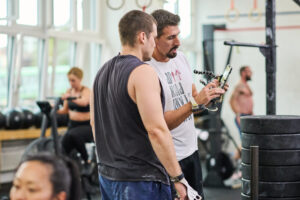
When people think about CrossFit, they often picture intense workouts with heavy weights, fast movements, and lots of sweat. That can lead to an important question: is CrossFit safe for beginners? The answer might surprise you—because the real risks don’t start where most people assume.
In this article, we’ll explain what CrossFit really is, how it differs from traditional fitness training, and why beginners are actually at the lowest risk of injury or overtraining.
What is CrossFit?
CrossFit is defined as “constantly varied functional movements performed at high intensity.” This means the workouts combine real-life movement patterns—like lifting, squatting, pulling, and jumping—in ever-changing ways to improve all-around fitness.
It’s not about getting good at one thing. It’s about becoming strong, fast, mobile, and resilient across all areas of fitness.
How CrossFit differs from traditional fitness training
The key difference between CrossFit and traditional fitness training is how strength and cardio are integrated.
In a standard gym setting, you might lift weights on one day and go for a run on another. These types of training are often kept separate.
CrossFit intentionally blends multiple training modalities within a single session or across a week—lifting weights, doing gymnastics, running, rowing, and more. This approach delivers faster, more transferable results and keeps training interesting and challenging.
So, is CrossFit safe for beginners?
Let’s address the big question directly: is CrossFit safe for beginners? The honest answer is: Yes. In fact, beginners are often the safest group in the gym.
That’s because when you’re just starting out, your capacity is still developing. You move more slowly, lift lighter weights, and your sessions are naturally lower in intensity—even if they feel hard. A good CrossFit gym will scale every workout to your level and guide you through proper technique step-by-step.
This means the perceived intensity (how hard it feels) might be high, but the absolute intensity (how much work your body is actually doing) is very low. That makes it extremely unlikely you’ll overtrain or injure yourself at this stage.
When does risk actually increase?
Ironically, it’s not beginners who are most at risk—it’s experienced athletes.
As you become stronger, faster, and more coordinated, your ability to push harder grows. You lift heavier weights, complete more reps, and move with greater efficiency. Your absolute intensity rises, and so does your potential for injury if you ignore recovery, technique, or mobility work.
But this isn’t unique to CrossFit—it’s true in any sport or training method. What keeps you safe isn’t avoiding intensity altogether—it’s learning how to train smart as you progress.
Absolute vs. perceived intensity
Here’s a concept that helps clarify things: the difference between absolute and perceived intensity.
- Perceived intensity is how hard a workout feels to you in the moment.
- Absolute intensity is how much physical stress is actually being applied—how heavy the load is, how fast you move, how many reps you complete.
In the beginning, perceived intensity can be high even when you’re doing simple movements with light loads. You’re working hard relative to your fitness level, but your body isn’t under enough strain to cause damage. That’s why CrossFit is safe for beginners, even when it feels like a tough workout.
Bottom line
So—is CrossFit safe for beginners? The answer is a clear yes.
With proper coaching, smart scaling, and supportive programming, CrossFit is one of the safest and most effective ways to start your fitness journey. The workouts are adapted to your level, progress is tracked, and you’re surrounded by coaches who make sure you’re moving well every step of the way.
If you’re thinking about getting started, know this: You’re safer starting CrossFit in a coached, supportive environment than trying to figure it all out on your own.




